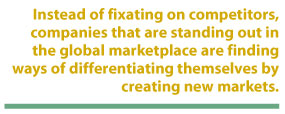October 2006 - Marketing Methods

How Successful Companies Adapt to Global Competition
By Peter Koeppel
The global marketplace is changing rapidly and competition is fiercer than ever. Asian companies are beginning to eclipse U.S. and European rivals in a range of industries, according to an August 21 article published in Business Week. Toyota will soon surpass General Motors as the largest auto manufacturer and the market cap of several Indian service companies are now approaching the size of General Motors. In a recent issue, Business Week explored ways that successful companies are adapting and staying ahead of the competition, which is information any direct marketer could benefit from.
Industries are under attack from competition that didn’t exist a few years ago. For example, eBay is taking on the major telecommunications companies through its free Internet phone service Skype. Google’s e-mail and word-processing services are taking on Microsoft and Google’s advertising services are challenging Madison Avenue. Instead of fixating on competitors, companies that are standing out in the global marketplace are finding ways of differentiating themselves by creating new markets. In today’s business environment, it’s sometimes more important to be unique rather than the biggest player in your industry. Business Week cites Whole Foods as an example of a smaller grocery retailer that found a profitable niche and brand loyalty among a group of customers interested in a healthier and more eco-friendly lifestyle.
DEVELOPING NEW MARKETS Cirque du Soleil, Apple and Starbucks are examples of companies that have created new markets and have reaped the rewards by producing innovative products, reports Business Week. How profitable can it be creating a new market vs. developing a product that is merely a brand extension? The article also cites research from a book, entitled Blue Ocean Strategy by W. Chan Kim and Renee Mauborgne, which shows that “86 percent of product launches that were line extensions accounted for 39 percent of the profits from all new-business launches from 108 companies tracked, but the remaining 14 percent of product launches that represented new markets accounted for 61 percent of profits!” The lesson here is that you don’t have to be a mega-brand to be profitable.
Cirque du Soleil, Apple and Starbucks are examples of companies that have created new markets and have reaped the rewards by producing innovative products, reports Business Week. How profitable can it be creating a new market vs. developing a product that is merely a brand extension? The article also cites research from a book, entitled Blue Ocean Strategy by W. Chan Kim and Renee Mauborgne, which shows that “86 percent of product launches that were line extensions accounted for 39 percent of the profits from all new-business launches from 108 companies tracked, but the remaining 14 percent of product launches that represented new markets accounted for 61 percent of profits!” The lesson here is that you don’t have to be a mega-brand to be profitable.
Understand what your customers want and use that information to your advantage. Google instantly surveys millions of consumers and businesses that have websites that link with one another. This allows the company to produce better search results than its competitors.
The trend towards mass producing products is also declining. Successful companies like Dell and Land’s End are supplying customers with customized computers and clothing, rather than trying to mass produce products appealing to the broadest audience. It’s also not enough to differentiate your company today by just being the low cost producer.
Competition is constantly evolving in today’s marketplace and the companies and their leaders that are in touch with the ways that winners are differentiating themselves are going to stay a step ahead of the competition.
Peter Koeppel is president of Koeppel Direct Inc., a full service media buying agency based in Dallas. He can be reached at (972) 732-6110, or via e-mail at [email protected].